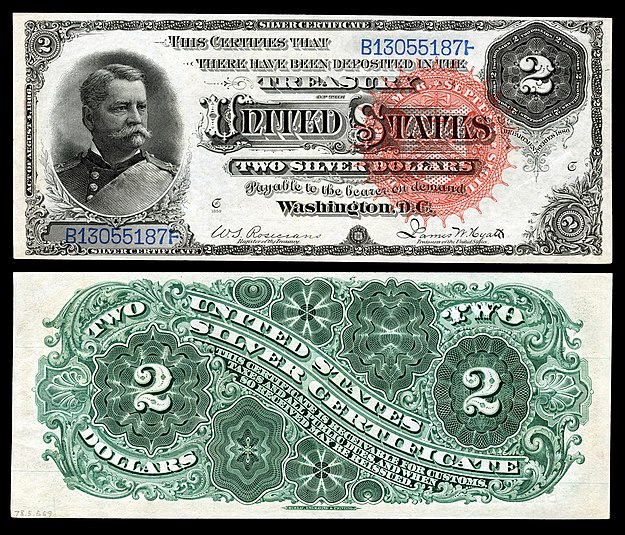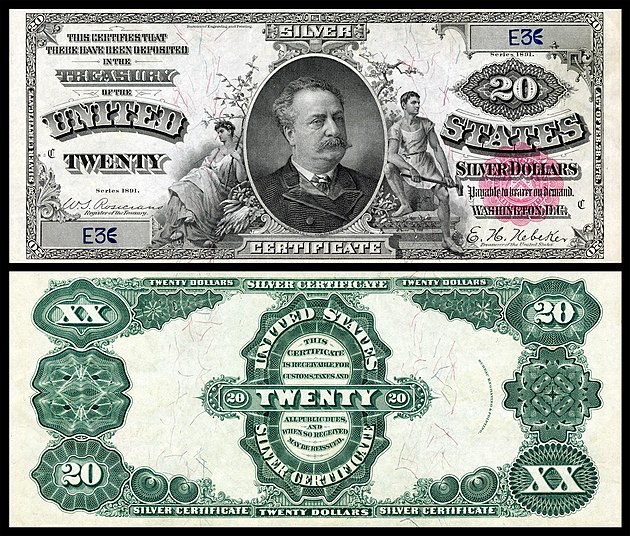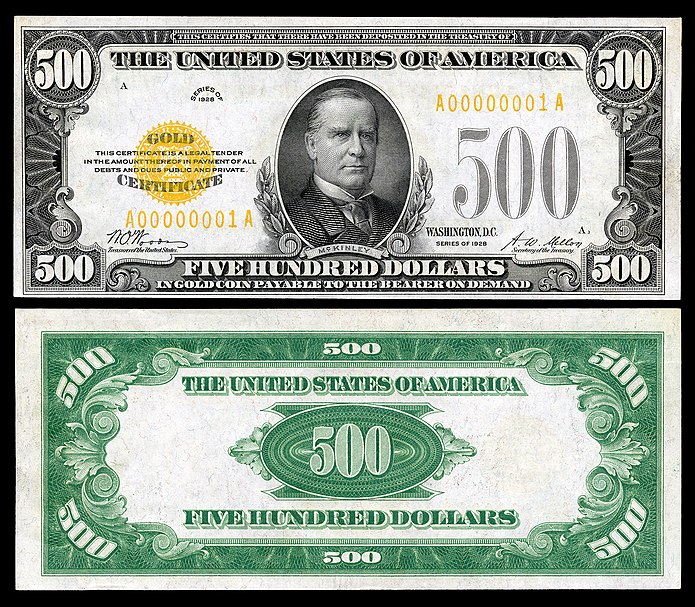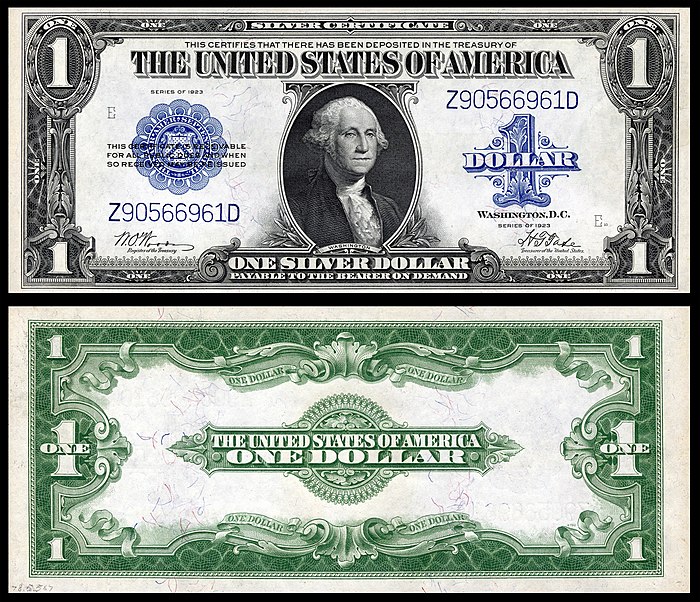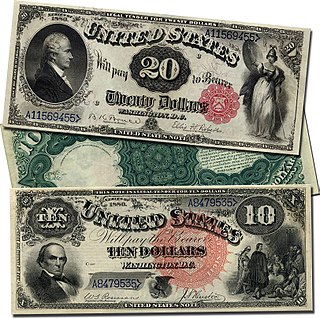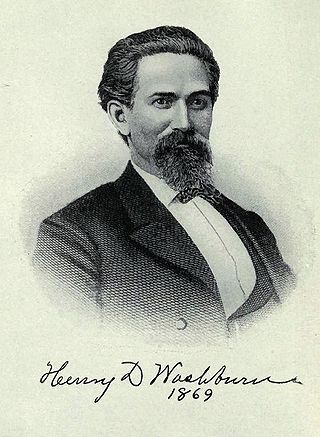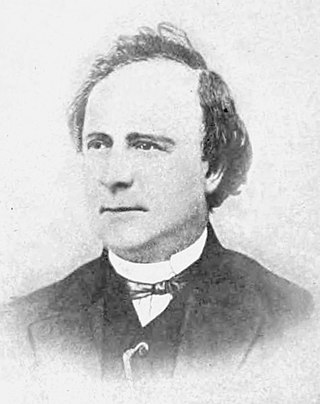People depicted
Each of the 53 individuals depicted on U.S. banknotes (not including fractional currency) is listed alphabetically with their most commonly associated titles, positions held, or affiliations (with dates). Elected and appointed government positions are fairly comprehensive and positions are presented in ascending chronological order.
| Name | Born | Died | Portrait [nb 6] | Title/comments | U.S. Banknote(s) [10] | IAD [11] |
|---|---|---|---|---|---|---|
| John Quincy Adams [12] | 11 Jul 1767 | 23 Feb 1848 | U.S. Minister to the Netherlands (1794–97), Prussia (1797–1801); State Senate (Massachusetts, 1802); U.S. Senate (Massachusetts, 1803–08); U.S. Minister to Russia (1809–14), Great Britain (1815–17); U.S. Secretary of State (1817–25); President of the United States (1825–29); U.S. House (Massachusetts, 1831–48). [13] | LT $500 (1869) | 1869 | |
| Thomas Hart Benton [14] | 14 Mar 1782 | 10 Apr 1858 | U.S. Senate (Missouri, 1821–51); U.S. House (Missouri, 1853–55). | GC $100 (1870) | 1870 | |
| Salmon Portland Chase [15] | 13 Jan 1808 | 7 May 1873 | U.S. Senate (Ohio, 1849–55 & 1861); Governor (Ohio, 1856–60); U.S. Secretary of the Treasury (1861–64); Chief Justice of the United States (1864–73). | LT $1 (1862) | 1861 | |
| William Clark | 1 Aug 1770 | 1 Sep 1838 | Explorer Captain, U.S. Army (1789–96); Superintendent of Indian Affairs (1807–13 & 1822–38); [16] Governor, Missouri Territory (1813–20). [17] | LT $10 (1901) | 1901 | |
| Henry Clay [18] | 12 Apr 1777 | 29 Jun 1852 | State House (Kentucky, 1803); U.S. Senate (Kentucky, 1806–07 & 1810–11); Speaker of the House (1811–14, 1815–20, 1823–25); U.S. Secretary of State (1825–29); U.S. Senate (Kentucky, 1831–43 & 1849–52). [19] | LT $50 (1869) | 1869 | |
| Grover Cleveland [20] | 18 Mar 1837 | 24 Jun 1908 | Governor (New York, 1883–85); President of the United States (1885–89, 1893–97). | FRBN $20 (1915) | 1914 | |
| DeWitt Clinton [21] | 2 Mar 1769 | 11 Feb 1828 | State House (New York, 1797–98); State Senate, (New York, 1798–1802 & 1805–11); U.S. Senate (New York, 1802–03); Mayor, New York City (1803–07, 1808-1810 & 1811–15); Lieutenant Governor (New York, 1811–13); Candidate for President (1812); Governor (New York, 1817–23, 1825–28). [22] | LT $1,000 (1869) | 1869 | |
| Stephen Decatur [23] | 5 Jan 1779 | 22 Mar 1820 | Commodore, U.S. Navy; Quasi-War, First Barbary War; Awarded Congressional Gold Medal (1813). | SC $20 (1878) | 1878 | |
| Edward Everett [24] | 11 Apr 1794 | 15 Jan 1865 | U.S. House (Massachusetts, 1825–35); Governor (Massachusetts, 1836–40); U.S. Minister to Great Britain (1841–45); U.S. Secretary of State (1852–53); U.S. Senate (Massachusetts, 1853–54). | SC $50 (1878) | 1878 | |
| David Glasgow Farragut [25] | 5 Jul 1801 | 14 Aug 1870 | Admiral, Commander-in-Chief (1861–70), [26] U.S. Navy (1810–1868); War of 1812, West Indies, American Civil War; Received Thanks of Congress (1862 [26] & 1866). [26] | TN $100 (1890) | 1890 | |
| William Pitt Fessenden [27] | 16 Oct 1806 | 8 Sep 1869 |  | State House (Maine, 1832, 1840, 1845–46, 1853–54); U.S. House (Maine, 1841–43); U.S. Senate (Maine, 1854–64); U.S. Secretary of the Treasury (1864–65). [28] | NBN $20 (1882, reverse) | 1882 [29] |
| Benjamin Franklin [30] | 17 Jan 1706 | 17 Apr 1790 | Founder; Delegate, Pennsylvania, Continental Congress; U.S. Postmaster General (1775, Inaugural Holder); Signer, Declaration of Independence (1776); U.S. Minister to France (1778–85), Sweden (1782–83); President of Pennsylvania and Delegate to the Constitutional convention (1785–88); Delegate, Pennsylvania, U.S. Constitutional Convention (1787). | LT $50 (1874) | 1874 | |
| Robert Fulton [31] | 14 Nov 1765 | 24 Feb 1815 | Engineer; Inventor | SC $2 (1896, reverse) | 1896 | |
| Albert Gallatin [32] | 29 Jan 1761 | 12 Aug 1849 | State House (Pennsylvania, 1790–92); U.S. Senate (Pennsylvania, 1793–94); U.S. House (Pennsylvania, 1795–1801); U.S. Secretary of the Treasury (1801–14); U.S. Minister to France (1815–23), Great Britain (1826–27). [33] | LT $500 (1862) | 1862 | |
| James Abram Garfield [34] | 19 Nov 1831 | 19 Sep 1881 | State Senate, (Ohio, 1859–61); [35] Major General, U.S. Army, (1861–63); [36] U.S. House (Ohio, 1863–81); President of the United States (1881). Shot by Charles J. Guiteau on 2 July 1881. [37] | NBN $5 (1882) | 1882 | |
| Ulysses S. Grant [38] | 27 Apr 1822 | 23 Jul 1885 | Commanding General (1864–69), U.S. Army (1843–54, 1861–69 & 1877–85); U.S. Secretary of War, (Interim, 12 August 1867 – 12 January 1868); [39] President of the United States (1869–77) Mexican–American War, American Civil War; Received Thanks of Congress (1863) and awarded The Congressional Gold Medal(1863). [40] | SC $1 (1899) | 1886 | |
| Alexander Hamilton [41] | 11 Jan 1757 | 12 Jul 1804 | Founder; Lieutenant Colonel, Continental Army (1775–); Continental Congress (1782–83); State House (New York, 1787); U.S. Secretary of the Treasury (1789–1795); Major General, Senior Officer, U.S. Army (1799–1800). [42] | DN $5 (1861) | 1861 | |
| Winfield Scott Hancock [43] | 14 Feb 1824 | 9 Feb 1886 | Major General (1866–1886), U.S. Army (1844–1886); Mexican–American War, American Civil War. Received Thanks of Congress (1866); [44] Candidate for President (1880). | SC $2 (1886) | 1886 | |
| Benjamin Harrison [45] | 20 Aug 1833 | 13 Mar 1901 |  | Brigadier General, U.S. Army (1862–65); [46] U.S. Senate (Indiana, 1881–87); President of the United States (1889–93). | NBN $5 (1902) | 1902 |
| Thomas Andrews Hendricks [47] | 7 Sep 1819 | 25 Nov 1885 | State House (Indiana, 1848–49); U.S. House (Indiana, 1851–55); Assistant Treasurer of the United States (1853); U.S. Senate (Indiana, 1863–69); Governor (Indiana, 1873–77); Vice President of the United States (1885, Died in Office). [48] | SC $10 (1886) | 1886 | |
| Michael Hillegas [49] | 22 Apr 1729 | 29 Sep 1804 | Provincial Assembly (Pennsylvania, 1765–75); Treasurer of the United States (1775–89, Inaugural Holder). | GC $10 (1907) | 1907 | |
| Andrew Jackson [50] | 15 Mar 1767 | 8 Jun 1845 | U.S. House (Tennessee, 1796–97); U.S. Senate (Tennessee, 1797–98); Judge, Tennessee Supreme Court (1798–1804); Major General, U.S. Army, Awarded Congressional Gold Medal(1815); Military Governor of Florida (10 March 1821 – 18 July 1821); U.S. Senate (Tennessee, 1823–25); President of the United States (1829–37). An assassination attempt (the first on a U.S. president) was made by Richard Lawrence on 30 January 1835 outside the Capitol building. [51] | LT $5 (1869) | 1861 | |
| Thomas Jefferson [52] | 13 Apr 1743 | 4 Jul 1826 | Founder; House of Burgesses (Virginia, 1769); Delegate, Virginia Continental Congress (1775–76 & 1783–84); Signer, Declaration of Independence (1776); Governor (Virginia, 1779–81); U.S. Minister to France (1785–1789); U.S. Secretary of State (1790–1793, Inaugural Holder ); Candidate for President (1796); Vice President of the United States (1797–1801); President of the United States (1801–1809). | LT $2 (1869) | 1869 | |
| John Jay Knox Jr. [53] | 19 Mar 1828 | 12 Feb 1892 |  | Comptroller of the Currency, Department of the Treasury (1872–84). [54] | NBN $100 (1902) | 1902 |
| Meriwether Lewis [55] | 18 Aug 1774 | 11 Oct 1809 | Explorer; Governor, Louisiana/Missouri Territory (1807–09). [56] | LT $10 (1901) | 1901 | |
| Abraham Lincoln [57] | 12 Feb 1809 | 15 Apr 1865 | State House (Illinois, 1834–41); U.S. House (Illinois, 1847–49); President of the United States (1861–65). [58] Assassinated by John Wilkes Booth on 15 April 1865. [59] | DN $1 (1861) | 1861 | |
| James Madison [60] | 16 Mar 1751 | 28 Jun 1836 | Founder; Member, First General Assembly of Virginia (1776); Delegate, Virginia, Continental Congress (1780–83 & 1786–88); Virginia House of Delegates (1783–86); U.S. Constitutional Convention (1787); U.S. House (Virginia, 1789–97); U.S. Secretary of State (1801–09); President of the United States (1809–17). | LT $5,000 (1878) | 1870 | |
| Daniel Manning | 16 May 1831 | 24 Dec 1887 | U.S. Secretary of the Treasury (1885–87) | SC $20 (1886) | 1886 | |
| Joseph King Fenno Mansfield [61] | 22 Dec 1803 | 18 Sep 1862 | Major General (1862), U.S. Army (1822–62); Mexican–American War, American Civil War. | LT $500 (1874) | 1874 | |
| William Learned Marcy [62] | 12 Dec 1786 | 4 Jul 1857 | Adjutant General, New York State Militia (1821–23); New York State Comptroller (1823); Judge, New York Supreme Court (1829–31); U.S. Senate (New York, 1831–33); Governor (New York, 1833–39); Commissioner of Mexican Claims (1839–42); U.S. Secretary of War (1845–49); U.S. Secretary of State (1853–57). [63] | SC $1,000 (1878) | 1878 | |
| John Marshall [64] | 24 Sep 1755 | 6 Jul 1835 | Captain, Continental Army (1776–81); [65] Virginia General Assembly (1782–91, 1797); U.S. Minister to France (1797); U.S. House (Virginia, 1799–1800); U.S. Secretary of State (1800–01); Chief Justice of the United States (1801–35). | TN $20 (1890) | 1890 | |
| Hugh McCulloch [66] | 7 Dec 1801 | 24 May 1895 |  | Comptroller of the Currency (1863–65); U.S. Secretary of the Treasury (1865–69 & 1884–85). | NBN $20 (1902) | 1902 |
| William McKinley Jr. [67] | 29 Jan 1843 | 14 Sep 1901 | Major, U.S. Army (1861–65); U.S. House (Ohio, 1877–84 & 1885–91); Governor (Ohio, 1892–96); [68] President of the United States (1897–1901). Shot by Leon Czolgosz on 6 September 1901. [69] | NBN $10 (1902) | 1902 | |
| James Birdseye McPherson [70] | 14 Nov 1828 | 22 Jul 1864 | Major General (1862–64), U.S. Army (1853–64), American Civil War; Killed in battle. [71] | TN $2 (1890) | 1890 | |
| George Gordon Meade [72] | 31 Dec 1815 | 6 Nov 1872 | Major General (1862–69), U.S. Army (1835–69); Mexican–American War, American Civil War; Received Thanks of Congress (1864). [73] | TN $1,000 (1890) | 1890 | |
| James Monroe [74] | 28 Apr 1758 | 4 Jul 1831 | Major, Continental Army (1776–79); Colonel, Virginia State Militia (1780); [75] Continental Congress (1783–1786); State House (Virginia, 1786 & 1810–11); U.S. Senate (Virginia, 1790–1794); U.S. Minister to France (1794–96); Governor (Virginia, 1799–1802 & 1811); U.S. Minister to Great Britain (1803–1807); U.S. Secretary of State (1811–1814 and 1815–1817); U.S. Secretary of War (Interim, 27 August 1814 – 15 March 1815); [76] President of the United States (1817–1825). | SC $100 (1878) | 1878 | |
| Robert Morris [77] | 31 Jan 1734 | 8 May 1806 | Founder; Delegate, Pennsylvania, Continental Congress (1776); Signer, Declaration of Independence (1776); State House (Pennsylvania, 1778–1781 and 1785–1787); United States Superintendent of Finance (1781–84). | LT $1,000 (1862) | 1862 | |
| Samuel Finley Breese Morse [78] | 27 Apr 1791 | 2 Apr 1872 | Inventor, [79] Morse Telegraph; Co-Inventor, Morse Code; Painter. [80] | SC $2 (1896, reverse) | 1896 | |
| Running Antelope | c.1821 | c.1896 | Sioux Chief of the Hunkpapa | SC $5 (1899) | 1899 | |
| Winfield Scott [81] | 13 Jun 1786 | 29 May 1866 | Commanding General (1841–61), U.S. Army (1808–61); War of 1812, Seminole Wars, Black Hawk War, Mexican–American War, American Civil War; Military Governor, Mexico City (1847–48); U.S. Secretary of War (Interim, 24 July 1850 – 15 August 1850); [82] Candidate for President (1852). Awarded Congressional Gold Medal (1814 [83] and 1848). [83] | IBN $500 [Two-Year] (1861) | 1861 | |
| William Henry Seward [84] | 16 May 1801 | 16 Oct 1872 | State Senate (New York, 1831–34); Governor (New York, 1839–43); U.S. Senate (New York, 1849–61); [85] U.S. Secretary of State (1861–69). An assassination attempt was made by Lewis Powell, a co-conspirator of John Wilkes Booth, the same night President Lincoln was shot (15 April 1865). [86] | TN $50 (1891) | 1891 | |
| Philip Henry Sheridan [87] | 6 Mar 1831 | 5 Aug 1888 | Commanding General (1883–88), U.S. Army (1853–88); American Civil War, Indian Wars. Received Thanks of Congress (1865). [87] | SC $5 (1896, reverse) | 1890 | |
| John Sherman [88] | 10 May 1823 | 22 Oct 1900 |  | U.S. House (Ohio, 1855–61); U.S. Senate (Ohio, 1861–77 & 1881–97); President pro tem, U.S. Senate (1885–87); [89] U.S. Secretary of the Treasury (1877–81); U.S. Secretary of State (1897–98). | NBN $50 (1902) | 1902 |
| William Tecumseh Sherman [90] | 8 Feb 1820 | 14 Feb 1891 | U.S. Secretary of War (Interim, 9 September 1869 – 18 October 1869); [89] Commanding General (1869–83), U.S. Army (1840–84); American Civil War, Indian Wars. Received Thanks of Congress (1864 [91] & 1865). [91] | TN $500 (1891) | 1891 [92] | |
| Edwin McMasters Stanton [93] | 19 Dec 1814 | 24 Dec 1869 | U.S. Attorney General (1860–61); U.S. Secretary of War (1862–68); U.S. Supreme Court (appointed 1869, died before taking office). [93] | TN $1 (1890) | 1890 | |
| Charles Sumner [94] | 6 Jan 1811 | 11 Mar 1874 | U.S. Senate (Massachusetts, 1851–74). | SC $500 (1878) | 1878 | |
| George H. Thomas [95] | 31 Jul 1816 | 28 Mar 1870 | Major General (1864–70), U.S. Army (1840–70); Mexican–American War, American Civil War. Received Thanks of Congress (1865). [96] | TN $5 (1890) | 1890 | |
| George Washington [97] | 22 Feb 1732 | 14 Dec 1799 | Founder; Virginia House of Burgesses (1758–75); [98] Delegate, VA, Continental Congress (1774–75); Commander-in-Chief, Continental Army (1775–83); [99] Member, U.S. Constitutional Convention (1787); President of the United States (1789–97); Lieutenant General, Commander of the United States Army (1798–99). [100] | LT $1 (1869) | 1861 | |
| Martha Washington [101] | 2 Jun 1731 | 22 May 1802 | First Lady of the United States (1789–97). | SC $1 (1886) | 1886 | |
| Daniel Webster [102] | 18 Jan 1782 | 24 Oct 1852 |  | U.S. House (New Hampshire, 1813–17); U.S. House (Massachusetts, 1823–27); U.S. Senate (Massachusetts, 1827–41 & 1845–50); Candidate for President (1836); U.S. Secretary of State (1841–43 & 1850–52). [103] | LT $10 (1869) | 1869 |
| Woodrow Wilson [104] | 28 Dec 1856 | 3 Feb 1924 |  | Governor (New Jersey, 1911–13); President of the United States (1913–21). Recipient of the Nobel Peace Prize (1919). [105] | SSN $100,000 (1934) | 1934 |
| William Windom [106] | 10 May 1827 | 29 Jan 1891 | U.S. House (Minnesota, 1859–69); U.S. Senate (Minnesota, 1870–71, 1871–81 & 1881–83); U.S. Secretary of the Treasury (1881, 1889–91). [104] | SC $2 (1891) | 1891 | |
| Silas Wright Jr. [107] | 24 May 1795 | 27 Aug 1847 | U.S. House (New York, 1827–29 & 1829–30); U.S. Senate (New York, 1833–44); Governor (New York, 1845–47). | GC $50 (1882) | 1882 |
















